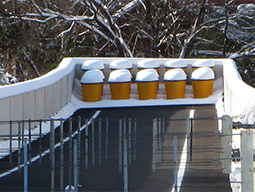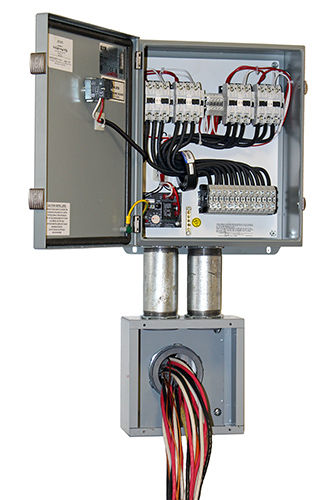Prior to Installing a Snow Melting System
If you’re looking to install a radiant heated driveway for a residential or commercial property, one of the first things you need to confirm is whether you have the necessary power requirements. In most cases, having the power needed to run an efficient radiant snow melting system is not a problem; however, prior to any installation, contractors should work with electricians to determine that the site will have the necessary power for heating the snowmelt area.
Contractors can use the following general information to quickly asses the power needs of a snow melting system. One 30-amp breaker supplies enough power to heat a 170-square foot area. To heat a driveway of 350-square feet, two 30-amp breakers (or one 60-amp breaker) would be needed. Homeowners can check their home’s main breaker panel to see the power coming into the house. (Typical homes feature either two 100 amp panels or two 200 amp breakers. These are located at the top of the main breaker box, above the main breaker panel.)

If you’re unsure of the square footage of your driveway, no worries; ProLine Radiant can calculate that for you too. In most areas, using a special state-of-the-art technology, ProLine can measure the area of your driveway while talking on the phone with you. Our helpful staff will work closely with you to ensure that the square footage of the area is measured correctly and the power requirements are therefore calculated properly.
On rare occasions when there is insufficient power available to operate a large driveway heating system, the radiant heat system can be laid out in zones. Each zone is powered separately. As a storm first hits, zone 1 would power up and melt the snow in that area of the driveway. After zone 1, zone 2 would then activate to melt the snow in that area of the driveway. Talk to a ProLine representative at 866.676.9276 for more detailed information about zoning your heated driveway.

When it comes to determining the power requirements for heating a specific area and what power is available, remember that you don’t have to figure this out by yourself. ProLine’s experienced reps are happy to work with you to not only help you determine the necessary power requirements, but to design a system that best meets the customers’ specific snow melting and budget needs. ProLine provides complete system design services, so prior to any installation, customers will know the exact layout and power requirements of the system.
Determining the Operating Cost of an Electric Heated Driveway
Homeowners are also keen to know the general operating costs of a heated driveway. Because radiant snow melting systems are specially designed for the specific demands of the average temperature and snowfall of their location, no two radiant heat systems are exactly alike. However, there is a formula that can be used to help you determine the approximate operating cost of a snow melting system.
General Guidelines to Determine a Heated Driveway’s Operating Cost
- Determine the total square footage of the area that will be heated.
- Multiply the square footage by the heat required (37 watts per sq. ft. for residential). This will give you a total for the watts per square footage required.
- Divide this number by 1,000 to convert to kilowatts.
- Look up the kilowatts-per-hour rate from the local power utility company.
- Multiply the total watts-per-square footage by the watts-per-hour. This gives you the cost-per-hour of usage for the snow melting system.
- NOTE: Heating cables and mats are rated in total watts. If the snowmelt system is intended for a commercial application, then you would multiply the total square footage by 50 watts to get a total wattage required. (E.g., 5,000 sq. ft. x 50 watts = 250,000 watts required.)
Radiant heat provides a range of benefits for home and business owners. The operating costs of automated snow melting systems are typically less than that of hiring professional snow removal services, and can help to extend the life of concrete driveways and keeps them from being subjected to abrasive snow removal methods or harsh snowmelt chemicals or salt. And since the systems are fully automated, business owners can be assured that walks and parking areas remain free from snow and ice during winter storms, enhancing safety for patrons.
